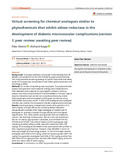| dc.description.abstract | Background: The polyol pathway contributes to the development of
diabetic complications but can be inhibited by plant phytochemicals.
This study aimed at assessing analogs of specific flavonoids that delay
onset of microvascular complications with better pharmacokinetic and
toxicology profiles.
Methods: An in silico study design was employed. The phytochemicals
luteolin and quercetin were selected. Analogs were obtained from
ZINC database and prepared using Avogadro software. Docking
analysis was done using AutoDock Vina embedded in Chimera. Ligand
enzyme interaction was carried out using Biovia Discovery studio.
Pharmacokinetic and toxicological profiling was carried out using
SWISSADME and protox server. A total of 40 analogues were analyzed.
Sulindac was used as the comparator besides original phytochemicals.
Results: Docking analysis showed both luteolin and quercetin (-9.7)
had a slightly stronger affinity for inhibiting aldose reductase
compared with sulindac (-9.6). Eight analogues of luteolin and 14
analogues of quercetin showed stronger affinity with the highest
registered at -10.6. Both luteolin and quercetin did not violate the
Lipinski rule, had high GI absorption, did not cross the blood brain
barrier nor were p-glycoprotein substrates, and inhibited CYP1A2,
CYP2D6 and CYP3A4. The LD50 of luteolin (3,919 mg/kg) was high
indicating excellent safety profile. Quercetin had a low LD50 (159
mg/kg). All 22 analogues exhibited similar pharmacokinetic profiles to
their respective phytochemical. However, they did differ in terms of
docking strength and toxicology analysis. Six out of the eight luteolin
analogues had LD50=3,919 mg/kg, while the remaining had LD50=159
mg/kg. Five quercetin analogues had LD50 of 159 mg/kg, another five
had LD50=3,919 mg/kg and the rest had LD50=4,000 mg/kg, while the
other two had a LD50 of 5,000 mg/kg.
Conclusions: In conclusion, six ZINC compounds similar to luteolin and nine similar to quercetin had stronger binding affinity for aldose
reductase and superior toxicological profile compared to parent
phytochemicals. | en_US |

